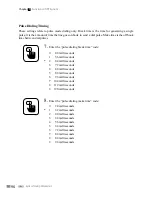
104
Ordinary Telephones
Introduction
This Chapter provides easy-to-follow instructions for the many useful and fl exible features built
into your BBS PABX Phone System.
The instructions assume that you are using a standard telephone, on a system equipped with
up to 4 outside lines and up to 16 extensions. If you are using a “key” telephone with separate
buttons for each extension and outside line, the use of certain features will be even easier (Refer
to page 130).
One person in your offi ce should be designated as the “System Manager”. This should be the
person who sets up and programms your system, and who is in possession of the User Guide.
Some pages in this Chapter refer you to the System Manager for more information.
Some features discussed may duplicate features built into your phone (auto redial, speed dial
numbers, etc.). If so, use whichever set of features you prefer.
Suggestions for Users
Take 20 minutes to read through the whole section. Try out each of the features discussed. Practise
using common features such as “Hold” and “Transfer”. This will help you to feel comfortable using
the features and to understand the many features available to you. It also help you to understand
the signals that your phone gives to indicate that someone else had “parked” a call for you, etc.
We also suggest keeping a “Dialing Code Sequence” by your phone; this shows the numbers for
each feature at a glance (see page 127).
How To Switch-hook
The “Switch-hook” (sometimes called a “Flash”) is a basic technique used to access phone system
features.
To perform a switch-hook, simply depress the switch-hook button for about half a second. (This
is the button in the phone cradle that is also used to disconnect the line). If this is done during an
outside conversation, a triple-beep will sound indicating that the switch-hook has registered.
If your phone has a “Flash” button, you can press it instead to perform a switch-hook.
Introduction
















































